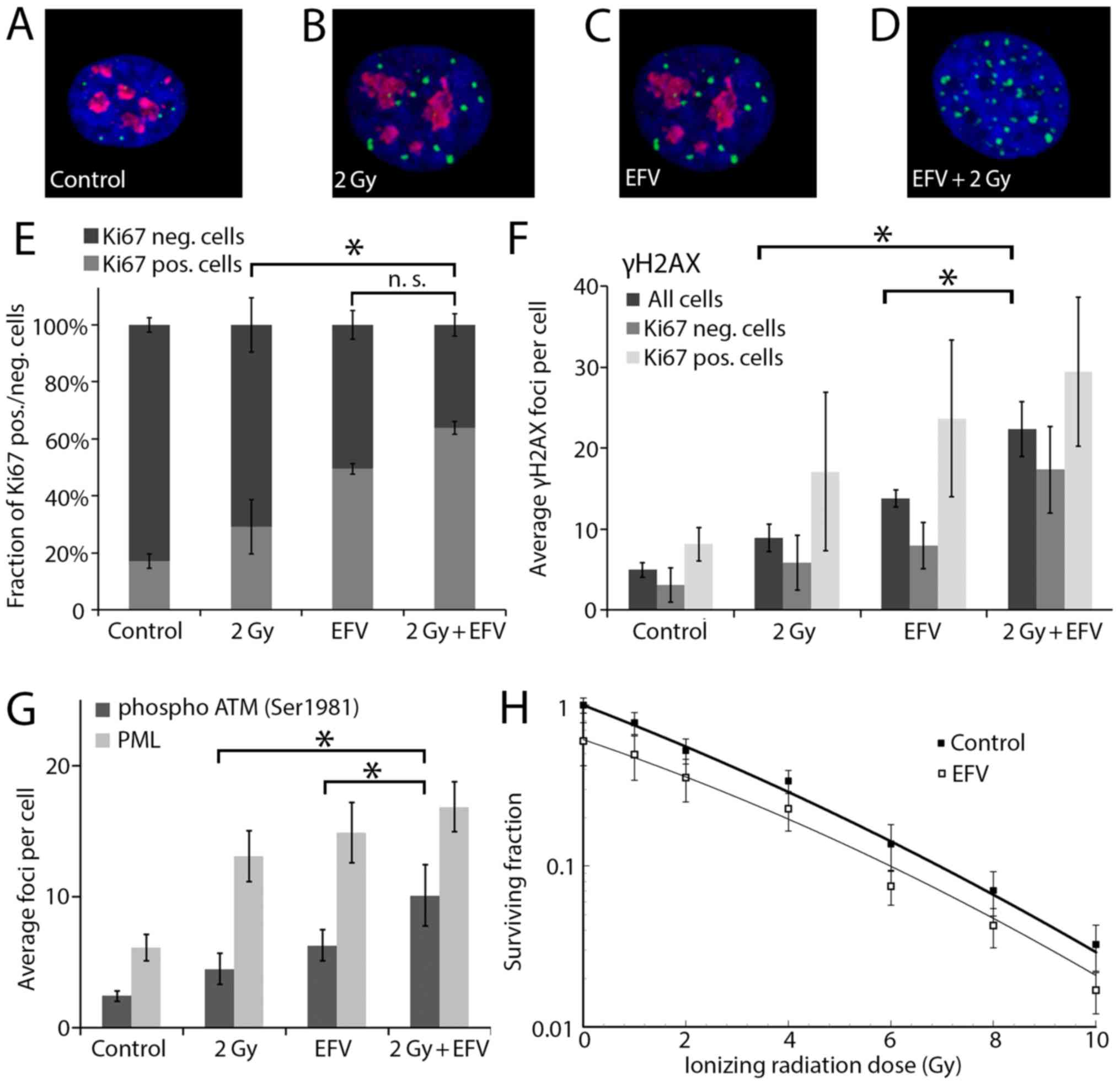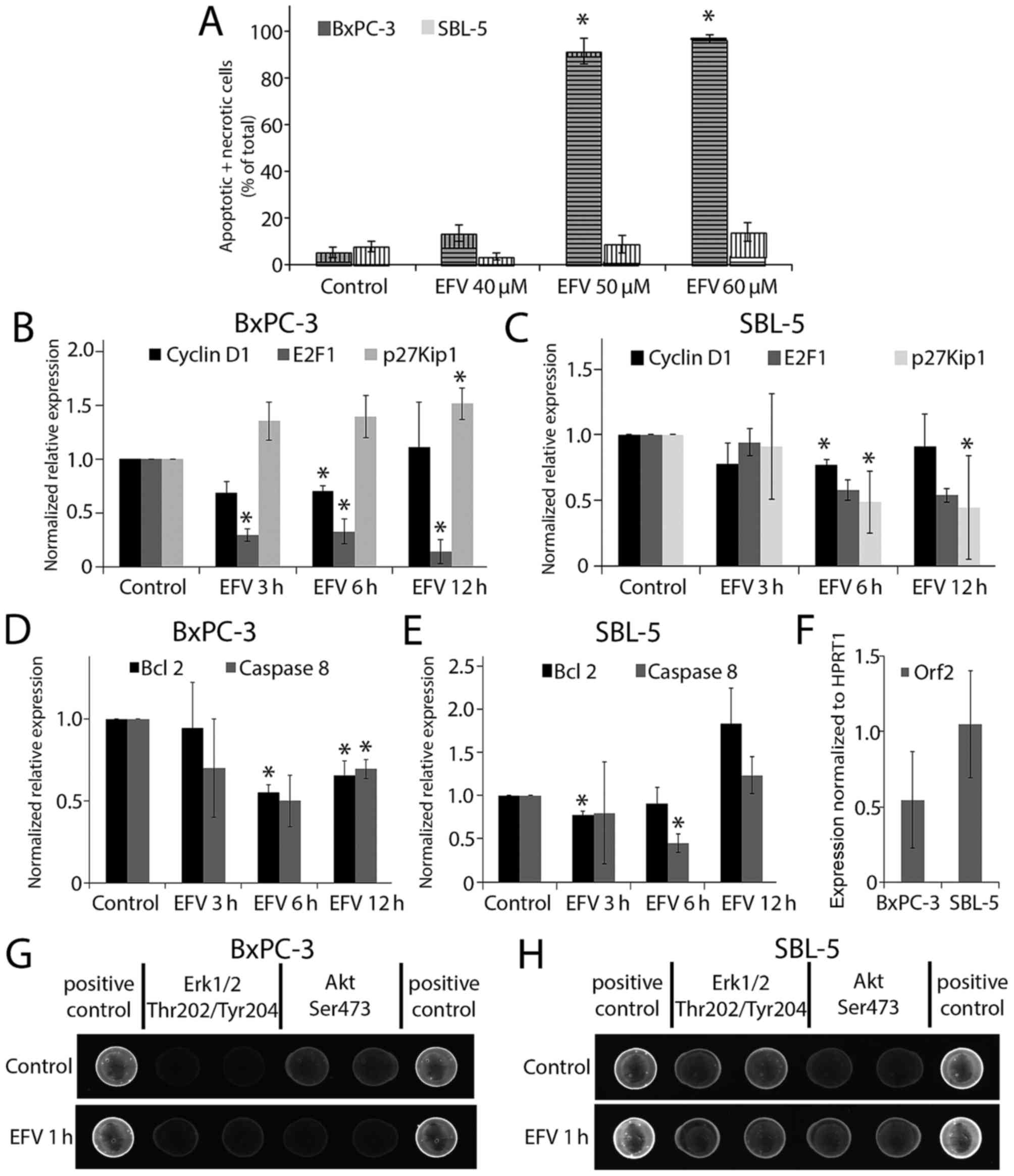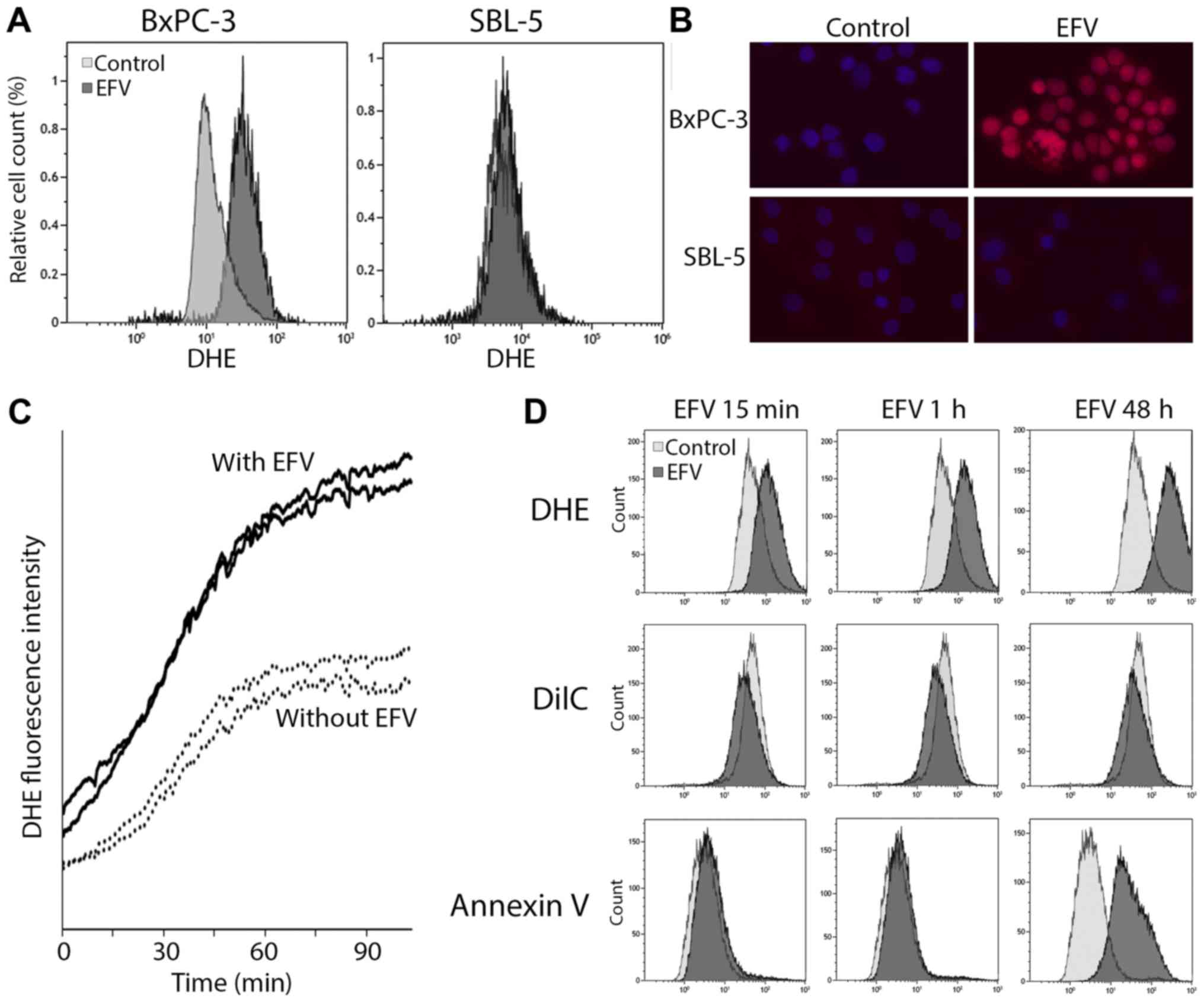|
1
|
Landriscina M, Altamura SA, Roca L,
Gigante M, Piscazzi A, Cavalcanti E, Costantino E, Barone C,
Cignarelli M, Gesualdo L and Ranieri E: Reverse transcriptase
inhibitors induce cell differentiation and enhance the immunogenic
phenotype in human renal clear-cell carcinoma. Int J Cancer.
122:2842–2850. 2008. View Article : Google Scholar : PubMed/NCBI
|
|
2
|
Landriscina M, Bagalá C, Piscazzi A,
Schinzari G, Quirino M, Fabiano A, Bianchetti S, Cassano A, Sica G
and Barone C: Nevirapine restores androgen signaling in
hormone-refractory human prostate carcinoma cells both in vitro and
in vivo. Prostate. 69:744–754. 2009. View Article : Google Scholar : PubMed/NCBI
|
|
3
|
Landriscina M, Fabiano A, Altamura S,
Bagalà C, Piscazzi A, Cassano A, Spadafora C, Giorgino F, Barone C
and Cignarelli M: Reverse transcriptase inhibitors down-regulate
cell proliferation in vitro and in vivo and restore thyrotropin
signaling and iodine uptake in human thyroid anaplastic carcinoma.
J Clin Endocrinol Metab. 90:5663–5671. 2005. View Article : Google Scholar : PubMed/NCBI
|
|
4
|
Mangiacasale R, Pittoggi C, Sciamanna I,
Careddu A, Mattei E, Lorenzini R, Travaglini L, Landriscina M,
Barone C, Nervi C, et al: Exposure of normal and transformed cells
to nevirapine, a reverse transcriptase inhibitor, reduces cell
growth and promotes differentiation. Oncogene. 22:2750–2761. 2003.
View Article : Google Scholar : PubMed/NCBI
|
|
5
|
Pittoggi C, Martis G, Mastrangeli G,
Mastrangeli B and Spadafora C: In vitro evidence for a new
therapeutic approach in renal cell carcinoma. Int Braz J Urol.
34:492–502. 2008. View Article : Google Scholar : PubMed/NCBI
|
|
6
|
Sciamanna I, Landriscina M, Pittoggi C,
Quirino M, Mearelli C, Beraldi R, Mattei E, Serafino A, Cassano A,
Sinibaldi-Vallebona P, et al: Inhibition of endogenous reverse
transcriptase antagonizes human tumor growth. Oncogene.
24:3923–3931. 2005. View Article : Google Scholar : PubMed/NCBI
|
|
7
|
Stefanidis K, Loutradis D, Vassiliou LV,
Anastasiadou V, Kiapekou E, Nikas V, Patris G, Vlachos G, Rodolakis
A and Antsaklis A: Nevirapine induces growth arrest and premature
senescence in human cervical carcinoma cells. Gynecol Oncol.
111:344–349. 2008. View Article : Google Scholar : PubMed/NCBI
|
|
8
|
Hecht M, Erber S, Harrer T, Klinker H,
Roth T, Parsch H, Fiebig N, Fietkau R and Distel LV: Efavirenz has
the highest anti-proliferative effect of non-nucleoside reverse
transcriptase inhibitors against pancreatic cancer cells. PLoS One.
10:e01302772015. View Article : Google Scholar : PubMed/NCBI
|
|
9
|
Hecht M, Harrer T, Büttner M, Schwegler M,
Erber S, Fietkau R and Distel LV: Cytotoxic effect of efavirenz is
selective against cancer cells and associated with the cannabinoid
system. AIDS. 27:2031–2040. 2013. View Article : Google Scholar : PubMed/NCBI
|
|
10
|
Sinibaldi-Vallebona P, Lavia P, Garaci E
and Spadafora C: A role for endogenous reverse transcriptase in
tumorigenesis and as a target in differentiating cancer therapy.
Genes Chromosomes Cancer. 45:1–10. 2006. View Article : Google Scholar : PubMed/NCBI
|
|
11
|
Ulrike K, Markus H, Thomas H, Ellen H,
Barbara S, Rainer F and Distel LV: NNRTI-based antiretroviral
therapy may increase risk of radiation induced side effects in
HIV-1-infected patients. Radiother Oncol. 116:323–330. 2015.
View Article : Google Scholar : PubMed/NCBI
|
|
12
|
Baues C, Semrau R, Gaipl US, Bröckelmann
PJ, Rosenbrock J, Engert A and Marnitz S: Checkpoint inhibitors and
radiation treatment in Hodgkin's lymphoma: New study concepts of
the German Hodgkin Study Group. Strahlenther Onkol. 193:95–99.
2017. View Article : Google Scholar : PubMed/NCBI
|
|
13
|
Schulze B, Meissner M, Ghanaati S, Burck
I, Rödel C and Balermpas P: Hedgehog pathway inhibitor in
combination with radiation therapy for basal cell carcinomas of the
head and neck: First clinical experience with vismodegib for
locally advanced disease. Strahlenther Onkol. 192:25–31. 2016.
View Article : Google Scholar : PubMed/NCBI
|
|
14
|
van den Berg-Wolf M, Hullsiek KH, Peng G,
Kozal MJ, Novak RM, Chen L, Crane LR and Macarthur RD; CPCRA 058
Study Team, the Terry Beirn Community Programs for Clinical
Research on AIDS (CPCRA), ; The International Network for Strategic
Initiative in Global HIV Trials (INSIGHT), : Virologic,
immunologic, clinical, safety, and resistance outcomes from a
long-term comparison of efavirenz-based versus nevirapine-based
antiretroviral regimens as initial therapy in HIV-1-infected
persons. HIV Clin Trials. 9:324–336. 2008. View Article : Google Scholar : PubMed/NCBI
|
|
15
|
Winkler S, Hoppe P, Haderlein M, Hecht M,
Fietkau R and Distel LV: Ex vivo apoptosis in CD8+ lymphocytes
predicts rectal cancer patient outcome. Gastroenterol Res Pract.
2016:50765422016. View Article : Google Scholar : PubMed/NCBI
|
|
16
|
Kotter B, Frey B, Winderl M, Rubner Y,
Scheithauer H, Sieber R, Fietkau R and Gaipl US: The in vitro
immunogenic potential of caspase-3 proficient breast cancer cells
with basal low immunogenicity is increased by hypofractionated
irradiation. Radiat Oncol. 10:1972015. View Article : Google Scholar : PubMed/NCBI
|
|
17
|
Endt H, Sprung CN, Keller U, Gaipl U,
Fietkau R and Distel LV: Detailed analysis of DNA repair and
senescence marker kinetics over the life span of a human fibroblast
cell line. J Gerontol A Biol Sci Med Sci. 66:367–375. 2011.
View Article : Google Scholar : PubMed/NCBI
|
|
18
|
Schwegler M, Wirsing AM, Dollinger AJ,
Abendroth B, Putz F, Fietkau R and Distel LV: Clearance of primary
necrotic cells by non-professional phagocytes. Biol Cell.
107:372–387. 2015. View Article : Google Scholar : PubMed/NCBI
|
|
19
|
Vandesompele J, De Preter K, Pattyn F,
Poppe B, Van Roy N, De Paepe A and Speleman F: Accurate
normalization of real-time quantitative RT-PCR data by geometric
averaging of multiple internal control genes. Genome Biol.
3:RESEARCH00342002. View Article : Google Scholar : PubMed/NCBI
|
|
20
|
Patnala R, Lee SH, Dahlstrom JE, Ohms S,
Chen L, Dheen ST and Rangasamy D: Inhibition of LINE-1
retrotransposon-encoded reverse transcriptase modulates the
expression of cell differentiation genes in breast cancer cells.
Breast Cancer Res Treat. 143:239–253. 2014. View Article : Google Scholar : PubMed/NCBI
|
|
21
|
Blois J, Smith A and Josephson L: The slow
cell death response when screening chemotherapeutic agents. Cancer
Chemother Pharmacol. 68:795–803. 2011. View Article : Google Scholar : PubMed/NCBI
|
|
22
|
Banno Y, Wang S, Ito Y, Izumi T, Nakashima
S, Shimizu T and Nozawa Y: Involvement of ERK and p38 MAP kinase in
oxidative stress-induced phospholipase D activation in PC12 cells.
Neuroreport. 12:2271–2275. 2001. View Article : Google Scholar : PubMed/NCBI
|
|
23
|
Matos TJ, Duarte CB, Gonçalo M and Lopes
MC: Role of oxidative stress in ERK and p38 MAPK activation induced
by the chemical sensitizer DNFB in a fetal skin dendritic cell
line. Immunol Cell Biol. 83:607–614. 2005. View Article : Google Scholar : PubMed/NCBI
|
|
24
|
Son Y, Cheong YK, Kim NH, Chung HT, Kang
DG and Pae HO: Mitogen-activated protein kinases and reactive
oxygen species: How can ROS activate MAPK pathways? J Signal
Transduct 2011. 7926392011.
|
|
25
|
Apostolova N, Gomez-Sucerquia LJ, Alegre
F, Funes HA, Victor VM, Barrachina MD, Blas-Garcia A and Esplugues
JV: ER stress in human hepatic cells treated with Efavirenz:
mitochondria again. J Hepatol. 59:780–789. 2013. View Article : Google Scholar : PubMed/NCBI
|
|
26
|
Apostolova N, Gomez-Sucerquia LJ, Gortat
A, Blas-Garcia A and Esplugues JV: Compromising mitochondrial
function with the antiretroviral drug efavirenz induces cell
survival-promoting autophagy. Hepatology. 54:1009–1019. 2011.
View Article : Google Scholar : PubMed/NCBI
|
|
27
|
Apostolova N, Gomez-Sucerquia LJ, Moran A,
Alvarez A, Blas-Garcia A and Esplugues JV: Enhanced oxidative
stress and increased mitochondrial mass during efavirenz-induced
apoptosis in human hepatic cells. Br J Pharmacol. 160:2069–2084.
2010. View Article : Google Scholar : PubMed/NCBI
|
|
28
|
Blas-Garcia A, Apostolova N, Ballesteros
D, Monleón D, Morales JM, Rocha M, Victor VM and Esplugues JV:
Inhibition of mitochondrial function by efavirenz increases lipid
content in hepatic cells. Hepatology. 52:115–125. 2010. View Article : Google Scholar : PubMed/NCBI
|
|
29
|
Gomez-Sucerquia LJ, Blas-Garcia A,
Marti-Cabrera M, Esplugues JV and Apostolova N: Profile of stress
and toxicity gene expression in human hepatic cells treated with
Efavirenz. Antiviral Res. 94:232–241. 2012. View Article : Google Scholar : PubMed/NCBI
|
|
30
|
Shiloh Y and Ziv Y: The ATM protein
kinase: Regulating the cellular response to genotoxic stress and
more. Nat Rev Mol Cell Biol. 14:197–210. 2013. View Article : Google Scholar
|
|
31
|
Baldin V, Lukas J, Marcote MJ, Pagano M
and Draetta G: Cyclin D1 is a nuclear protein required for cell
cycle progression in G1. Genes Dev. 7:812–821. 1993. View Article : Google Scholar : PubMed/NCBI
|
|
32
|
Johnson DG, Schwarz JK, Cress WD and
Nevins JR: Expression of transcription factor E2F1 induces
quiescent cells to enter S phase. Nature. 365:349–352. 1993.
View Article : Google Scholar : PubMed/NCBI
|
|
33
|
Polyak K, Lee MH, Erdjument-Bromage H,
Koff A, Roberts JM, Tempst P and Massagué J: Cloning of p27Kip1, a
cyclin-dependent kinase inhibitor and a potential mediator of
extracellular antimitogenic signals. Cell. 78:59–66. 1994.
View Article : Google Scholar : PubMed/NCBI
|
|
34
|
Hatok J and Racay P: Bcl-2 family
proteins: Master regulators of cell survival. Biomol Concepts.
7:259–270. 2016. View Article : Google Scholar : PubMed/NCBI
|
|
35
|
Ebrahimi S, Hosseini M, Shahidsales S,
Maftouh M, Ferns GA, Ghayour-Mobarhan M, Hassanian SM and Avan A:
Targeting the Akt/PI3K signaling pathway as a potential therapeutic
strategy for the treatment of pancreatic cancer. Curr Med Chem.
24:1321–1331. 2017. View Article : Google Scholar : PubMed/NCBI
|
|
36
|
Manning BD and Cantley LC: AKT/PKB
signaling: Navigating downstream. Cell. 129:1261–1274. 2007.
View Article : Google Scholar : PubMed/NCBI
|
|
37
|
Sciamanna I, Gualtieri A, Cossetti C,
Osimo EF, Ferracin M, Macchia G, Aricò E, Prosseda G, Vitullo P,
Misteli T and Spadafora C: A tumor-promoting mechanism mediated by
retrotransposon-encoded reverse transcriptase is active in human
transformed cell lines. Oncotarget. 4:2271–2287. 2013. View Article : Google Scholar : PubMed/NCBI
|
|
38
|
Landriscina M, Modoni S, Fabiano A,
Fersini A, Barone C, Ambrosi A and Cignarelli M: Cell
differentiation and iodine-131 uptake in poorly differentiated
thyroid tumour in response to nevirapine. Lancet Oncol. 7:877–879.
2006. View Article : Google Scholar : PubMed/NCBI
|
|
39
|
Modoni S, Landriscina M, Fabiano A,
Fersini A, Urbano N, Ambrosi A and Cignarelli M: Reinduction of
cell differentiation and 131I uptake in a poorly differentiated
thyroid tumor in response to the reverse transcriptase (RT)
inhibitor nevirapine. Cancer Biother Radiopharm. 22:289–295. 2007.
View Article : Google Scholar : PubMed/NCBI
|
|
40
|
Amengual JE, Zhang X, Ibrahim S and
Gardner LB: Regression of HIV-related diffuse large B-cell lymphoma
in response to antiviral therapy alone. Blood. 112:4359–4360. 2008.
View Article : Google Scholar : PubMed/NCBI
|
|
41
|
Girard T, Luquet-Besson I, Baran-Marszak
F, Raphael M and Boue F: HIV+ MALT lymphoma remission induced by
highly active antiretroviral therapy alone. Eur J Haematol.
74:70–72. 2005. View Article : Google Scholar : PubMed/NCBI
|
|
42
|
Houédé N, Pulido M, Mourey L, Joly F,
Ferrero JM, Bellera C, Priou F, Lalet C, Laroche-Clary A, Raffin
MC, et al: A phase II trial evaluating the efficacy and safety of
efavirenz in metastatic castration-resistant prostate cancer.
Oncologist. 19:1227–1228. 2014. View Article : Google Scholar : PubMed/NCBI
|












